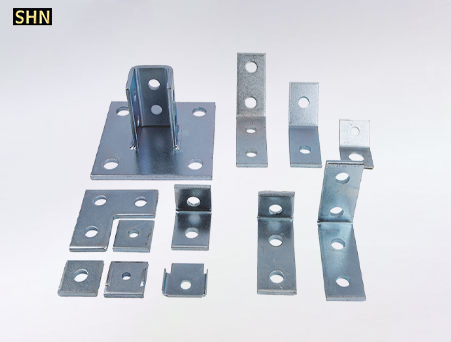+86 10 5248 4022
+86 18518927929

Jul. 28, 2023
What are strut channel fittings used for?
Strut channel fittings are used to create strong and flexible support structures in various applications. They are commonly used in construction, electrical, mechanical, and plumbing industries. The fittings are designed to be compatible with strut channels, which are long metal channels with slots for easy attachment.
Some common uses of slotted strut fittings include:
Supporting electrical conduit and cable trays.
Creating frameworks for HVAC systems and ducts.
Building sturdy racks and shelves for storage.
Installing piping systems for plumbing and gas lines.
Constructing safety barriers and handrails.
Mounting equipment and machinery securely.
Designing custom frameworks for solar panel installations.
Creating modular structures for DIY projects and prototyping.
Overall, strut channel fittings provide a versatile and reliable solution for organizing and supporting various components in different industries.
How do strut channel fittings enhance structural support?
Strut channel hardware enhance structural support in several ways:
1. Strength and Durability: Strut channel fittings are typically made of strong materials, such as steel or aluminum, which provide excellent structural integrity and can withstand heavy loads.
2. Flexibility: The design of strut channel systems allows for flexibility in creating support structures. Fittings can be easily connected and adjusted along the channels to accommodate various configurations and changes in the layout.
3. Load Distribution: By distributing loads over a wider area, strut channel accessories help reduce stress on individual components, resulting in more even weight distribution and increased overall stability.
4. Versatility: These fittings come in various shapes and sizes, allowing them to adapt to different support needs. Whether it's supporting pipes, conduits, or equipment, strut channel fittings can be tailored to specific requirements.
5. Vibration Damping: When used to support mechanical equipment, strut channel systems can dampen vibrations, reducing the risk of damage or wear caused by excessive movement.
6. Corrosion Resistance: Many strut channel fittings are coated or made from materials with excellent corrosion resistance, making them suitable for both indoor and outdoor applications, even in harsh environments.
Overall, unistrut fittings offer a robust and adaptable support solution, enhancing the structural integrity and stability of various systems and constructions.
Are strut channel fittings compatible with different strut channel sizes?
Yes, strut channel fittings are designed to be compatible with different strut channel sizes. Strut channels, also known as channel struts or structural struts, come in various standardized sizes, such as 1-5/8 inches (41 mm), 1-1/4 inches (32 mm), 2-1/2 inches (64 mm), etc. The fittings are engineered to fit these standard channel dimensions, ensuring a proper and secure connection.
SSHN produce a wide range of channel strut fittings, including connectors, brackets, clamps, hangers, and other accessories, all specifically designed to work with different strut channel sizes. This versatility allows for the construction of support structures tailored to the specific needs of a project or application.
When selecting strut channel fittings, it is essential to ensure that they match the size of the corresponding strut channel to achieve a stable and reliable support system. Additionally, some fittings may have adjustable components or multiple mounting options to accommodate various channel sizes, providing further flexibility in their usage.
What materials are commonly used to manufacture strut channel fittings?
Strut channel fittings are manufactured using various materials, with the choice of material depending on the specific application, environmental factors, and load requirements. Some of the commonly used materials for making strut channel accessories include:
Steel: Steel is one of the most common materials for strut channel fittings. It offers excellent strength and durability, making it suitable for heavy-duty applications. Steel fittings are often galvanized or coated to provide corrosion resistance.
Stainless Steel: Stainless steel fittings are highly corrosion-resistant and are ideal for applications in corrosive environments or where hygiene is essential. They are commonly used in the food and beverage industry, pharmaceuticals, and outdoor installations.
Aluminum: Aluminum fittings are lightweight and offer good corrosion resistance, making them suitable for applications where weight reduction is important or in environments with moderate corrosion concerns.
Zinc-Plated Steel: Zinc-plated steel fittings provide added corrosion resistance due to the protective zinc coating. They are often used in indoor applications where moisture levels are not excessively high.
Hot-Dip Galvanized Steel: Hot-dip galvanized fittings are coated with a thicker layer of zinc, offering superior corrosion protection. They are commonly used in outdoor and marine applications, where exposure to harsh elements is a concern.
The choice of material depends on factors such as the intended application, the environment in which the fittings will be used, and the level of corrosion resistance needed. Proper material selection ensures that the strut channel fittings offer the required strength, durability, and performance for their intended purpose.

Previous Channel Strut Fittings
Slotted Channel - for light structural support
Dec. 11, 2023How to Attach slotted channel to a Beam?
Dec. 11, 2023Leave Message
Write down your urgent needs to get free samples, and to check our stocks

Copyright © SS&HN INDUSTRY GROUP Ltd. All Rights Reserved | Sitemap | Powered by 